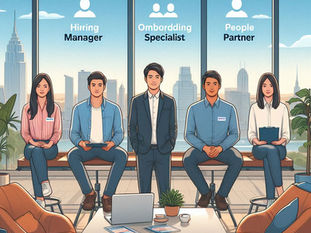
The Five Stages of Onboarding a New Employee - [Day 1 to Day 90]
Sep 29, 2024
3 min read
0
1
0

The Five Stages of Onboarding a New Employee
Onboarding a new employee is a critical process that sets the foundation for their success in your organization. A well-structured onboarding experience can lead to higher productivity, increased engagement, and lower turnover. At **Delegate**, we emphasize a clear, phased approach to onboarding to ensure a smooth transition. Here, we'll walk you through the **five essential stages** of onboarding: Orientation, Role-Specific Training, Meetings and Introductions, Integration, and Feedback Loops.
Orientation
The first step of onboarding is the **Orientation**, where the new employee gets acquainted with the company's values, culture, policies, and processes. This stage provides a general overview of the organization's mission, vision, and structure, helping the employee understand how their role contributes to the overall goals. During orientation, employees typically:
Complete necessary paperwork (tax forms, benefits enrollment, etc.).
Review company policies, like attendance, dress code, and communication guidelines.
Explore the company’s mission, vision, and values.
Get introduced to the tools and systems they’ll be using daily.
Orientation is about making new hires feel welcomed, valued, and informed. It's the perfect opportunity to set a positive tone and establish connections right from the start.
Role-Specific Training
Once the employee has a good understanding of the company, it's time for **Role-Specific Training**. This phase is tailored to the specific responsibilities and technical requirements of the new hire’s role. During this stage, new hires:
Learn about their key tasks and objectives.
Receive training on tools, systems, and software they will use.
Review expectations and performance metrics.
Understand the processes and workflows associated with their team.
This phase can include hands-on training, job shadowing, and online learning resources. The goal is to ensure the employee has the skills, knowledge, and confidence to perform their role effectively.
Meetings and Introductions
For new employees to thrive, they need to build relationships with their peers, supervisors, and cross-functional teams. The **Meetings and Introductions** stage focuses on fostering these connections. New hires will:
Meet with their direct team and cross-functional colleagues.
Get introduced to key stakeholders, mentors, or department heads.
Participate in informal or formal meet-and-greet sessions.
Understand the roles and responsibilities of people they will interact with regularly.
This stage helps new hires understand who to approach for specific tasks or guidance and creates a sense of belonging in the workplace.
4. Integration
After the initial training and introductions, it’s time for the new hire to integrate into their role and team fully. In this **Integration** stage, employees begin applying what they’ve learned, taking on responsibilities, and working on real projects. At this point, the focus is on:
Adjusting to team dynamics and workplace norms.
Practicing role-specific tasks and receiving feedback.
Engaging in ongoing learning and development opportunities.
Participating in regular check-ins with managers or mentors.
Integration is about transitioning from learning to doing, with the goal of making the employee feel like an active, contributing member of the team.
Feedback Loops
The final stage of onboarding is **Feedback Loops**, which emphasizes continuous communication and improvement. Managers, mentors, and the new hire should actively seek and provide feedback throughout the onboarding process. During this stage:
Regular check-ins with managers allow for feedback on performance and adjustments.
Employees have the opportunity to share their experiences, ask questions, and clarify expectations.
Feedback from peers and mentors provides insights into strengths and areas for improvement.
Feedback Loops ensure that the onboarding process remains dynamic and responsive, allowing new hires to continuously grow and feel supported as they settle into their roles.
Conclusion
Onboarding is much more than a one-day event—it’s a strategic process that should evolve over time. Each of these five stages—**Orientation**, **Role-Specific Training**, **Meetings and Introductions**, **Integration**, and **Feedback Loops**—helps to ensure that new hires feel welcomed, prepared, and supported as they begin their journey with your company.
At Delegate, we’ve designed our platform to streamline each of these stages, ensuring an engaging, structured onboarding experience that sets new employees up for long-term success.
This blog post can be customized to reflect your company’s approach or include specific tools or processes you use for onboarding. Would you like me to add more detail or expand on any of the stages?




